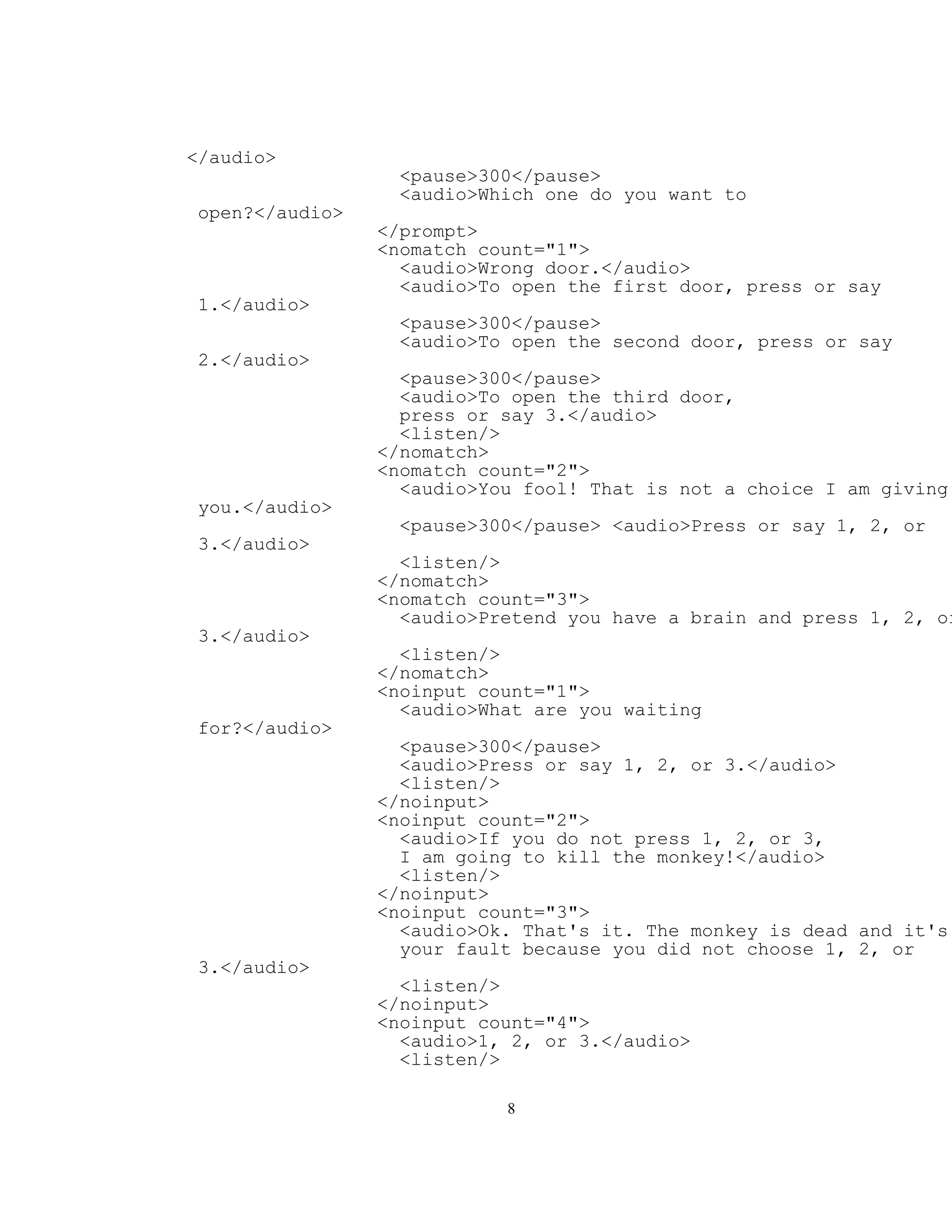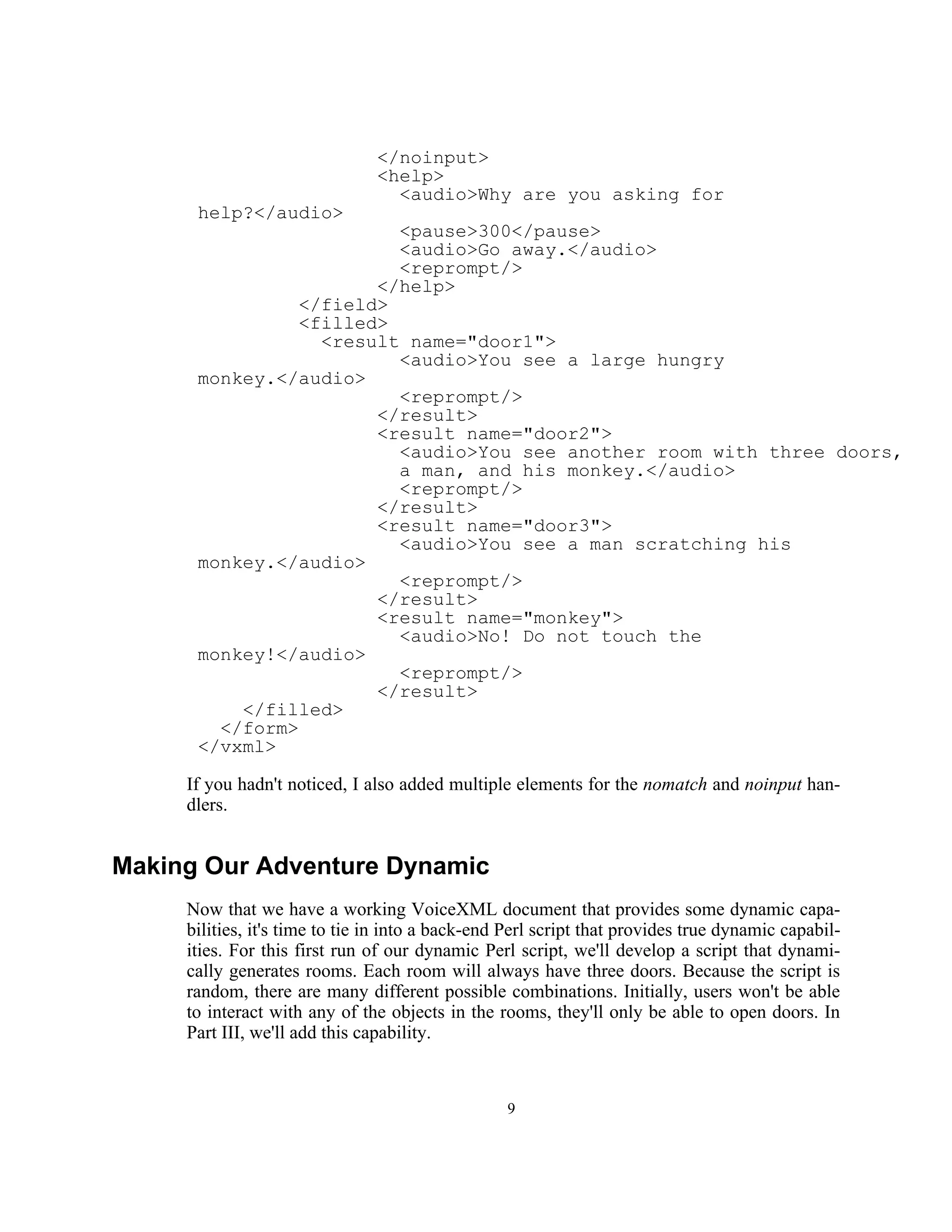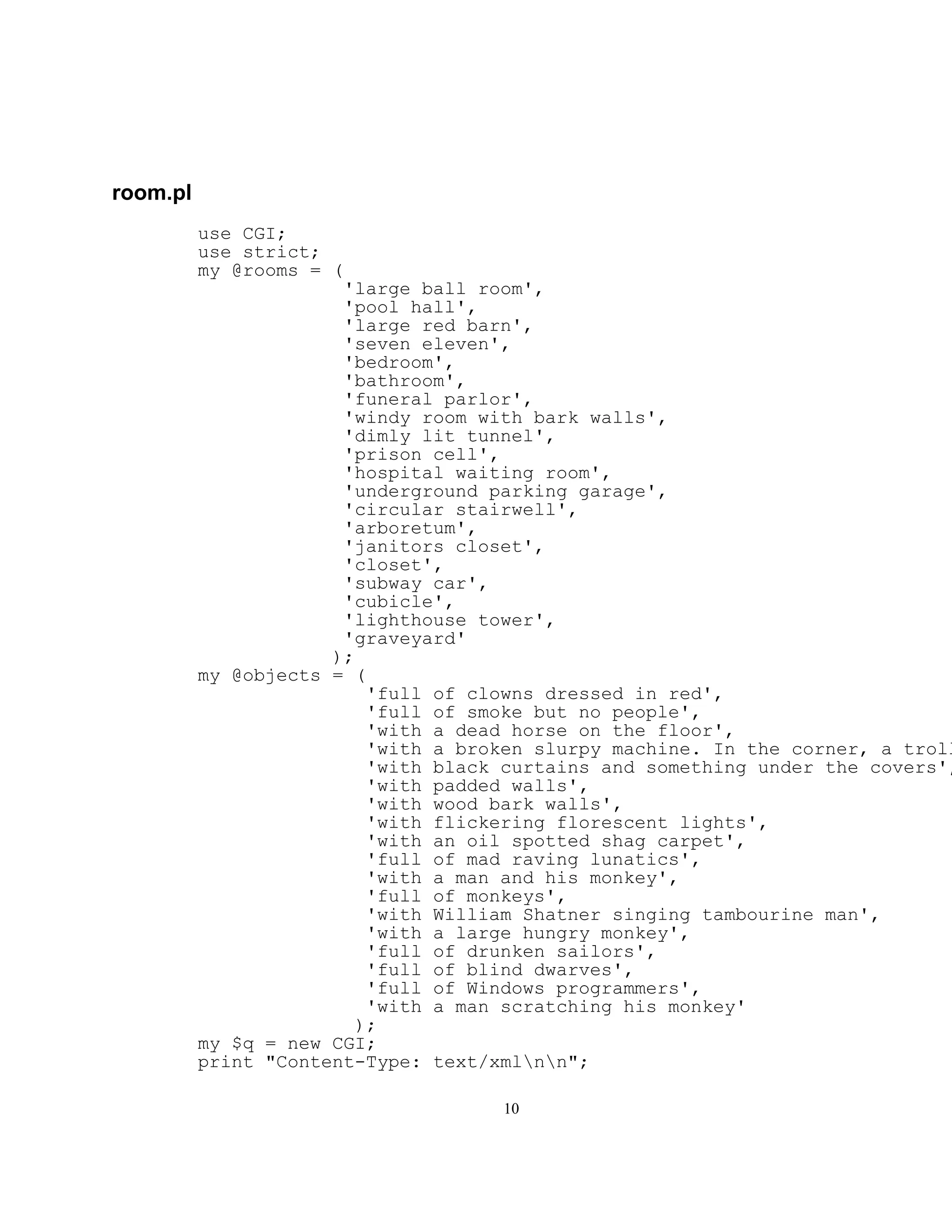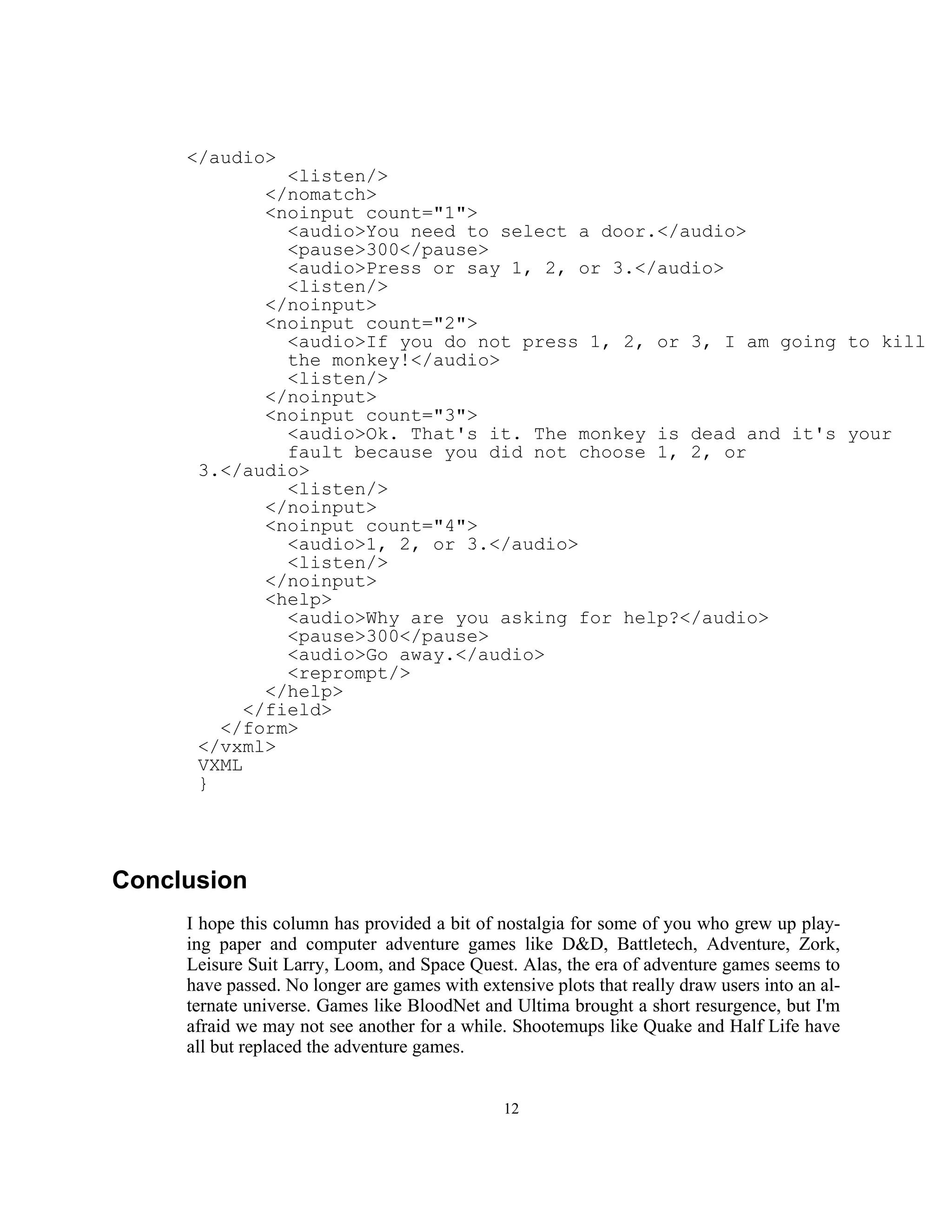The document describes developing a simple text adventure game using VoiceXML. It will allow the user to provide input using DTMF tones or voice commands to interact with the game. The tutorial provides 3 code examples that start with a basic grammar accepting DTMF input for 3 doors, then expands it to also allow voice commands. It adds event handlers for nomatch and noinput events to the third example. Live demos of the code can be accessed by calling a Tellme phone number and entering the tutorial option and example number.
![VoiceXML Adventure Game
Jonathan Eisenzopf
Copyright © 2001 by internet.com
March 8, 2001
Continuing from Part I [http://webref.com/perl/tutorial/20] of our comprehensive series
of VoiceXML tutorials, in Part II we will develop a simple, but fully dynamic
VoiceXML application in Perl for the Tellme.com voice portal.
Overview
"You are in an open field west of a big white house with a
boarded front door. There is a small mailbox here."
Do you remember the original Zork text adventure game and Choose Your Own Ad-
venture books? Maybe you're even old enough to remember the original Adventure
game. If you don't, you're missing out. We're going to develop a simple Zork-like ap-
plication using VoiceXML. In Part III, we will create a more advanced version that uti-
lizes its own XML format for building text adventures.
Examples
As we step through each code example, you will also be able to dial into Tellme and
demo the code live on the Mother of Perl Tellme extension. Simply dial 1-800-tellme,
wait for the Tellme main menu, then dial 1-73759. You will hear a greeting and a
menu of options. Dial 2 for Tutorial 21 and then press the number that corresponds
with the example in the tutorial. For example, when you see:
Example 1.
you can interact with the source code by pressing 1 on your phone. Each example is
also linked to the XML source code file, where you can examine the file in your Web
browser, or launch it directly into your favorite XML editor.
In addition to the live examples, you will find the source code for all examples in the
tutorial21.zip [tutorial21.zip] file, which you can use for free to create your own
VoiceXML applications.
Creating a Grammar for DTMF Input
Grammars
1](https://image.slidesharecdn.com/2620521/75/tutorial21-1-2048.jpg)
![Before we proceed any further, we need to talk a bit more about grammars. They are a
very important part of any VoiceXML document. A grammar is a set of expressions
that define what DTMF tones and spoken input will be recognized by the system.
These grammars are limited to what you program them to recognize. Depending on
where you place the grammar, the scope can be the whole document, a form, or a field
within a form. The Tellme grammar syntax uses the Nuance Grammar Specification
Language (GSL).
It's not too difficult to define a simple grammar that allows a user to make a selection
via DTMF tones. Let's define a simple grammar that provides our users with the option
to open one of three doors in our adventure.
<grammar><![CDATA[
[
[dtmf-1] {<option "door1">}
[dtmf-2] {<option "door2">}
[dtmf-3] {<option "door3">}
]
]]>
</grammar>
First, grammars are placed within the grammar element. You should also surround the
grammar with a CDATA section, which tells the XML parser not to process the text in-
side. In the grammar above, we have defined three options. Each option is defined by a
grammar statement. The statement consists of an expression to be matched, and the
corresponding value to return when a match occurs.
The expression used to match a digit is: dtmf-$ where $ is the number we want to
match. For example, dtmf-1 would be matched if a user presses 1 on their telephone
keypad.
The second part of the expression defines the value that will be returned when we get a
match. For example, {<option "foo">} will return the text foo when the user in-
put matches the first part of the expression.
Next we're going to apply this simple grammar to a real VoiceXML document.
Getting DTMF Input
The first version of our adventure game below will only accept DTMF input. The user
can select 1, 2, or 3, which corresponds with one of the three doors.
An example user session follows:
2](https://image.slidesharecdn.com/2620521/75/tutorial21-2-2048.jpg)
![Tellme: You are in a small room with three doors.
Tellme: To open the first door, press 1.
Tellme: To open the second door, press 2.
Tellme: To open the third door, press 3.
User: (pressed 1)
Tellme: You see a large hungry monkey.
Now, let's take a look at the VoiceXML document.
Example 1. [example1.xml]
<?xml version="1.0"?>
<vxml version="1.0">
<form>
<field name="answer">
<grammar><![CDATA[
[
[dtmf-1] {<option "door1">}
[dtmf-2] {<option "door2">}
[dtmf-3] {<option "door3">}
]
]]>
</grammar>
<prompt><audio>You are in a small room with three
doors.</audio>
<pause>300</pause> <audio>To open the first door, press
1.</audio>
<pause>300</pause> <audio>To open the second door, press
2.</audio>
<pause>300</pause> <audio>To open the third door, press
3.</audio> </prompt>
</field>
<filled>
<result name="door1">
<audio>You see a large hungry monkey.</audio>
<reprompt/>
</result>
<result name="door2">
<audio>You see another room with three doors, a man, and his
monkey.</audio>
<reprompt/>
</result>
<result name="door3">
3](https://image.slidesharecdn.com/2620521/75/tutorial21-3-2048.jpg)
![<audio>You see a man scratching his
monkey.</audio>
<reprompt/>
</result>
</filled>
</form>
</vxml>
For more information on using the filled and result elements, please see Page 3
[http://webref.com/perl/tutorial/20/3.html] of the first part of this tutorial. You might
have also noticed the pause element in the example above. Using the element forces
Tellme.com to pause between prompts. In this case, we want to stop for 300 millisec-
onds between options to duplicate the pause that would occur in natural speech.
Adding Voice Selections
Now that we have a simple interactive application working, we need to add the ability
for users to provide voice commands in addition to DTMF input. This is done by
adding additional grammar expressions.
<grammar><![CDATA[
[
[dtmf-1 one] {<option "door1">}
[dtmf-2 two] {<option "door2">}
[dtmf-3 three] {<option "door3">}
[(touch the monkey)] {<option "monkey">}
]
]]>
</grammar>
If you compare the new grammar element above to the one on the previous page, you'll
notice that we've added addition information for each option as well as a new line. The
addition information consists of a single word for each option. For example, the first
line of the grammar instructs the Tellme VoiceXML parser to match when the user
presses 1 on their keypad or if they speak the word one. The last line of the grammar
matches on the phrase, "touch the monkey." There will not be a match if the user says
"touch" or "monkey." It will only match when the user says "touch the monkey." This
is because the phrase is contained within paretheses, which require that the whole
phrase be matched.
Example 2. [example2.xml]
<?xml version="1.0"?>
<vxml version="1.0">
<form>
4](https://image.slidesharecdn.com/2620521/75/tutorial21-4-2048.jpg)
![<field name="answer">
<grammar> <![CDATA[
[
[dtmf-1 one] {<option "door1">}
[dtmf-2 two] {<option "door2">}
[dtmf-3 three] {<option "door3">}
[(touch the monkey)] {<option "monkey">}
]
]]>
</grammar>
<prompt> <audio>You are in a small room with thr
doors.</audio>
<pause>300</pause> <audio>To open the first do
1.</audio>
<pause>300</pause> <audio>To open the second d
2.</audio>
<pause>300</pause> <audio>To open the third do
3.</audio>
</prompt>
</field>
<filled>
<result name="door1">
<audio>You see a large hungry
monkey.</audio>
<reprompt/>
</result>
<result name="door2">
<audio>You see another room with three doors,
monkey.</audio>
<reprompt/>
</result>
<result name="door3">
<audio>You see a man scratching his
monkey.</audio>
<reprompt/>
</result>
<result name="monkey">
<audio>No! Do not touch the
monkey!</audio>
<reprompt/>
</result>
</filled>
</form>
</vxml>
Handling Events
Next, we need to add handlers for the nomatch and noinput events using the methods
5](https://image.slidesharecdn.com/2620521/75/tutorial21-5-2048.jpg)
![specified in Page 4 [http://www.webref.com/perl/tutorial/20/4.html] of the previous tu-
torial.
Example 3. [example3.xml]
<?xml version="1.0"?>
<vxml version="1.0">
<form>
<field name="answer">
<grammar> <![CDATA[
[
[dtmf-1 one] {<option "door1">}
[dtmf-2 two] {<option "door2">}
[dtmf-3 three] {<option "door3">}
[(touch the monkey)] {<option "monkey">}
]
]]>
</grammar>
<prompt> <audio>You are in a small room with thr
doors.</audio>
<pause>300</pause>
<audio>To open the first door, press or say
1.</audio>
<pause>300</pause>
<audio>To open the second door, press or say
2.</audio>
<pause>300</pause>
<audio>To open the third door, press or say
3.</audio>
</prompt>
<nomatch>
<audio>You fool! That is not a choice I am giv
you.</audio>
<pause>300</pause>
<audio>Press or say 1, 2, or
3.</audio>
<listen/>
</nomatch>
<noinput>
<audio>What are you waiting
for?</audio>
<pause>300</pause>
<audio>Press or say 1, 2, or
3.</audio>
<listen/>
</noinput>
</field>
<filled>
<result name="door1">
<audio>You see a large hungry
6](https://image.slidesharecdn.com/2620521/75/tutorial21-6-2048.jpg)
![</audio>
<reprompt/>
</result>
<result name="door2">
<audio>You see another room with three doors,
monkey.</audio>
<reprompt/>
</result>
<result name="door3">
<audio>You see a man scratching his
monkey.</audio>
<reprompt/>
</result>
<result name="monkey">
<audio>No! Do not touch the
monkey!</audio>
<reprompt/>
</result>
</filled>
</form>
</vxml>
Adding Help
In most VoiceXML applications, you'll want to provide some help facility. Most peo-
ple expect to get some kind of help when they press 0 on their phone, whether it be a
live operator or automated assistance. In the example below, we've added a DTMF and
voice grammar item that calls the help element in the document below.
Example 4. [example4.xml]
<?xml version="1.0"?>
<vxml version="1.0">
<form>
<field name="answer">
<grammar> <![CDATA[
[
[dtmf-1 one first] {<option "door1">}
[dtmf-2 two second] {<option "door2">}
[dtmf-3 three third] {<option "door3">}
[(touch the monkey)] {<option "monkey">}
[dtmf-0 huh help what doh] {<option "help">}
]
]]>
</grammar>
<prompt>
<audio>You are in a small room with three
7](https://image.slidesharecdn.com/2620521/75/tutorial21-7-2048.jpg)



![&prompt;
sub prompt {
my $room = $rooms[int(rand(scalar(@rooms)))];
my $object = $objects[int(rand(scalar(@objects)))];
print <<VXML;
<?xml version="1.0"?>
<vxml version="1.0">
<form>
<field name="answer">
<grammar>
<![CDATA[
[
[dtmf-1 one first] {<option "door1">}
[dtmf-2 two second] {<option "door2">}
[dtmf-3 three third] {<option "door3">}
[(touch the monkey)] {<option "monkey">}
[dtmf-0 huh help what doh] {<option "help">}
]
]]>
</grammar>
<prompt>
<audio>You are in a $room $object. There are three
doors.</audio>
</prompt>
<filled>
<submit
next="http://www.textant.com/cgi-bin/room.pl"/>
</filled>
<nomatch count="1">
<audio>Wrong door.</audio>
<audio>To open the first door, press or say
1.</audio>
<pause>300</pause>
<audio>To open the second door, press or say
2.</audio>
<pause>300</pause>
<audio>To open the third door, press or say
3.</audio>
<listen/>
</nomatch>
<nomatch count="2">
<audio>You fool! That is not a choice I am giving
you.</audio>
<pause>300</pause>
<audio>Press or say 1, 2, or 3.</audio>
<listen/>
</nomatch>
<nomatch count="3">
<audio>Pretend you have a brain and press 1, 2, or
11](https://image.slidesharecdn.com/2620521/75/tutorial21-11-2048.jpg)

